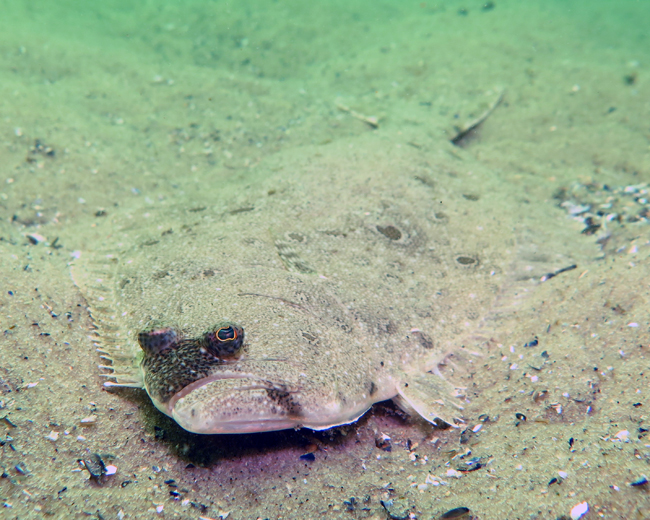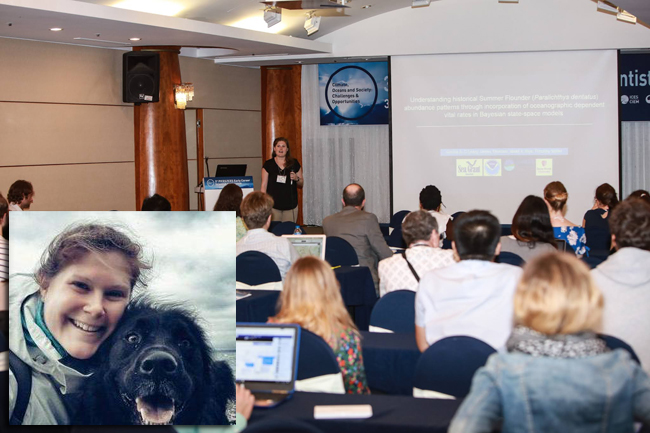
Summer flounder are masters of camouflage, but can they hide from ecological pressures over time along the U.S. East Coast? New York Sea Grant-funded researchers have developed models and tools that can help us understand the health of these and other fisheries going forward and particularly in future scenarios with a changing climate. Credit: Chris Paparo/@fishguyphotos
—Chris Gonzales, Freelance Science Writer, New York Sea Grant
Stony Brook, NY, September 7, 2020 - It’s a conundrum for somebody fishing: If the fish aren’t biting, does it mean their numbers are dwindling?
A New York Sea Grant–funded research team led by Janet Nye, an ecologist and associate professor at Stony Brook University’s (SBU) School of Marine and Atmospheric Sciences (SoMAS), used data and mathematical models to shed light on this question. The modeling, done by then–SoMAS PhD student Cecilia O’Leary, who now works as a fisheries research scientist for NOAA, focused on summer flounder, one of the most important fisheries on the U.S. East Coast.
Three publications by O’Leary as lead author explore the role of environmental conditions on fish numbers, size, and management recommendations. The first article emphasizes the importance of modeling both fishing and oceanographic conditions simultaneously and has been published in the Canadian Journal of Fisheries and Aquatic Sciences (1). Another recent publication in the same journal is concerned primarily with what factors determine the size of the fish from year to year (2). A third article published in ICES Journal of Marine Science focuses on a data modeling technique of transferring observed changes in productivity into reference points, or values that are used in fisheries management as indicators of how well a stock is doing (3).
More complicated than at first seems
The question: Can we figure out why the numbers of fish are changing over time?
O’Leary and colleagues used historical trawl data, landings data, key information about the ocean, and in some cases fish geographic locations, including data going back to the 1980s. The team studied summer flounder in particular because it is a single species that ranges along the East Coast of the U.S. and is important to recreational and commercial fisheries in this region.
“We looked at whether the number of summer flounder was linked to ocean conditions,” said O’Leary. “If so, do ocean conditions influence the number of new fish or the number of fish that die of natural causes? We investigated this while also accounting for the amount of fishing pressure on this stock.”
This study (1) found that the year-to-year changes in how many fish there are can be linked to variations in the population due to environmental conditions. The models and tools they developed can help us understand the health of our fisheries going forward, across species, and particularly in future scenarios with a changing climate.
Size of fish
Environmental conditions can also affect how fish thrive.
“In our follow up study (2), with new mathematical techniques we confirmed that summer flounder found further north and in deeper waters tend to be larger than average. We also discovered that when the Gulf Stream is pushed north and when conditions on the shelf tend to be warmer than average, summer flounder tend to be larger than average and to be found further north on the continental shelf,” said O’Leary. “This study does not track individual fish, but rather the population as a whole.”
“These two studies combined tell us that ocean conditions driven by the Gulf Stream position can be used as an indicator for the number of summer flounder over time. It provides us with more information to track how summer flounder are doing each year.”
Significance of the Gulf Stream
“We used the position of the Gulf Stream as a general indicator of overall ocean conditions,” said O’Leary. “The Gulf Stream position is related to conditions in the Northwest Atlantic, such as temperature, as well as other environmental factors, such as how strong currents are and how many cross-shelf eddies there are.
We found that increases in past numbers of summer flounder were linked to the position of the Gulf Stream as well as a reduction in fishing pressure, but it’s not a simple linear relationship.
When the Gulf Stream is in a more extreme position, either much further north (so the warmer Gulf Stream waters reach the continental shelf) or much further south than the average position over time, the loss of summer flounder due to natural mortality decreased. This link of ocean conditions to natural mortality, or fish that die of causes other than fishing pressure, is the novel part of our study that nobody has explored as much that we are aware of.”
Getting accurate interpretations in a changing environment

Cecilia O’Leary presents on summer flounder population dynamics at the International Council for the Exploration of the Sea (ICES) and the ICES North Pacific Section (PICES) Early Career Scientist Conference, Spring 2017, in Busan, South Korea. Credit: ICES; Inset: Cecilia O’Leary and her dog Shackleton. Credit: Cecilia O’Leary.
If scientists and managers don’t account for the impact of changing environmental conditions on fish, the indicators used to determine how well a stock is doing might be slightly off and lead to a conclusion that the stock is doing better or worse than it actually is. As such, in a third study (3), O’Leary and her team worked to develop management biological reference points, used to determine if the fishing on a stock is at an okay level, too high, or too low, that incorporates any information we have on how the environment impacts fish numbers.
Investigators found that there were differences in reference points based upon how environmental conditions were considered to influence summer flounder as well as whether or not that influence was static or varied over time.
Now we have a better understanding of why the populations of summer flounder in the Northeast US have fluctuated quite a bit over the last few decades.
“This work emphasizes the importance of modelling fishing and climate in combination to understand what’s going on in fish stocks because all of these factors are interacting together to influence how many fish there are in the ocean,” said O’Leary.
Although not the purpose of the study, it provides a better understanding of how environmental conditions affect the summer flounder population, which may allow scientists and fisheries managers to understand how climate change combined with different levels of fishing pressure will impact population size. “We know that the position of the Gulf Stream will likely be in a more northerly position more often as anthropogenic climate change progresses,” said Nye. “So, summer flounder may be found further north, larger in general and natural mortality may be low, but fishing pressure will strongly impact the population size.”
NMFS-Sea Grant Joint Fellowship Overview
The research was part of the National Marine Fisheries Service (NMFS)—Sea Grant Joint Fellowship Program. The NMFS-Sea Grant Joint Fellowship Program in Population and Ecosystem Dynamics and Marine Resource Economics is designed to help Sea Grant fulfill its broad educational responsibilities and to strengthen the collaboration between Sea Grant and the National Marine Fisheries Service (NMFS). Since 1990, Sea Grant and NMFS have partnered to train students through this joint fellowship program in two specialized areas: population and ecosystem dynamics as well as marine resource economics. Population and ecosystem dynamics involve the study of fish populations and marine ecosystems to better assess fish stock abundance and dynamics.
References
1 Understanding historical summer flounder (Paralichthys dentatus) abundance patterns through the incorporation of oceanography-dependent vital rates in Bayesian hierarchical models. Cecilia A. O’Leary, Timothy J. Miller, James T. Thorson, Janet A. Nye. Canadian Journal of Fisheries and Aquatic Sciences, 2019, 76(8): 1275-1294. December 2018.
2 Detecting somatic growth trends for summer flounder (Paralichthys dentatus) using a state-space approach. Cecilia A. O’Leary, Christine C. Stawitz, Janet A. Nye. Canadian Journal of Fisheries and Aquatic Sciences, 2020, 77(5): 917-930. December 2019.
3 Comparison of multiple approaches to calculate time-varying biological reference points in climate-linked population-dynamics models. Cecilia A O’Leary, James T Thorson, Timothy J Miller, Janet A Nye. ICES Journal of Marine Science, Volume 77, Issue 3, May-June 2020, Pages 930–941.
More Info: New York Sea Grant
New York Sea Grant (NYSG), a cooperative program of Cornell University
and the State University of New York (SUNY), is one of 34 university-based
programs under the National Oceanic and Atmospheric Administration’s
National Sea Grant College Program.
Since 1971, NYSG has represented a statewide network of integrated
research, education and extension services promoting coastal community
economic vitality, environmental sustainability and citizen awareness
and understanding about the State’s marine and Great Lakes resources.
Through NYSG’s efforts, the combined talents of university scientists
and extension specialists help develop and transfer science-based
information to many coastal user groups—businesses and industries,
federal, state and local government decision-makers and agency managers,
educators, the media and the interested public.
The program maintains Great Lakes offices at Cornell University, University at Buffalo, SUNY Oswego and the Wayne County Cooperative Extension office
in Newark. In the State's marine waters, NYSG has offices at Stony Brook
University in Long Island, Brooklyn College and Cornell Cooperative
Extension in NYC and Kingston in the Hudson Valley.
For updates on Sea Grant activities: www.nyseagrant.org has RSS, Facebook, Twitter, Instagram, and YouTube links. NYSG offers a free e-list sign up via www.nyseagrant.org/nycoastlines for its flagship publication, NY Coastlines/Currents, which is published quarterly. Our program also produces an occasional e-newsletter,"NOAA Sea Grant's Social Media Review," via its blog, www.nyseagrant.org/blog.